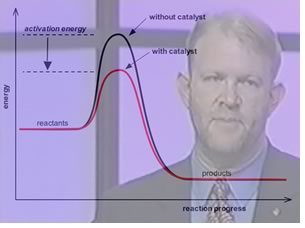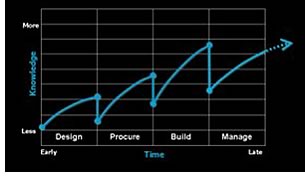

10/2005
by
Phillip Bernstein, FAIA
Vice president, building industry division, Autodesk
![]() In chemical engineering, something is said to act as a “catalyst” when
it significantly lowers the energy required for a reaction to occur.
The catalyst is not the reason the reaction takes place—it is simply
the missing ingredient that makes a reaction practical and energy-efficient.
At the end of the process, the catalyst remains unchanged, but it has
helped to create a desired result.
In chemical engineering, something is said to act as a “catalyst” when
it significantly lowers the energy required for a reaction to occur.
The catalyst is not the reason the reaction takes place—it is simply
the missing ingredient that makes a reaction practical and energy-efficient.
At the end of the process, the catalyst remains unchanged, but it has
helped to create a desired result.
 That’s
precisely the role technology is playing in one of the most dramatic
changes in the profession of architecture in decades, perhaps longer.
I’m talking about the vision of creating an “integrated
practice,” moving from traditional ways of doing business into
fully collaborative, highly integrated, and productive teams that include
all the stakeholders in a project’s lifecycle. It’s a vision
of a building process where information flows freely and can be used
where it is most needed. In integrated practice, projects are optimized
for client outcomes, rather than for the individual business objectives
of designers, constructors, and owners. (Click image for Bernstein’s
comments during a 2005 panel discussion on BIM; 8MB)
That’s
precisely the role technology is playing in one of the most dramatic
changes in the profession of architecture in decades, perhaps longer.
I’m talking about the vision of creating an “integrated
practice,” moving from traditional ways of doing business into
fully collaborative, highly integrated, and productive teams that include
all the stakeholders in a project’s lifecycle. It’s a vision
of a building process where information flows freely and can be used
where it is most needed. In integrated practice, projects are optimized
for client outcomes, rather than for the individual business objectives
of designers, constructors, and owners. (Click image for Bernstein’s
comments during a 2005 panel discussion on BIM; 8MB)
A business reality
The most important factor behind this evolutionary change is not technology,
as some speculate, but business reality. Technology is just a catalyst
to effect a needed change that addresses failures that have long been
recognized in the building industry.
Traditional methods are too costly, too wasteful, and don’t take into account the full life cycle of a building. Traditional industry practices do not provide sufficient access to sufficient information for everyone involved to make crucial decisions under today’s pressures of time, budget, and accountability. Traditional methods do not deliver the outcomes clients demand in today’s business climate.
There are three major reasons for this state of affairs:
- The gap between the activities of design (the process of defining the intent of the project) and construction (the actualization of that intent) has widened to the breaking point
- The specific business interests of each player in that process, where thin profits must be fiercely protected and risk transferred rather than mitigated, have become as important as successfully completing the building
- We’ve created silos of expertise and liability, resulting in an overall process that was once aptly characterized by a colleague at Stanford as “sub-optimized to the point of failure.”
It’s no wonder that AEC risks remain high and margins low, with clients dissatisfied in the main with our results. A recent client survey of owners highlighted one such painful point: 70 percent felt that document quality was declining, and a stunning 98 percent felt that architects should be held more responsible for increasing document quality. That to me is an indictment of our current processes.
Greater insight needed
What the industry faces can be summed up as a demand for greater insight into the increasingly complex collections of information that make
up what we call a design. It’s crucial that this insight be available
as early in the creation process as possible—that’s when
there is the greatest potential to affect the building’s cost
and function with the least cost in dollars and time.
In addition to creating insight early, we need to establish a context in which this insight can arise throughout the various business processes that create a building. This new context blurs roles, changes responsibilities, shifts potential liability, and demands new contract models and instruments of service. While technology might create the mechanisms for such a context by allowing the sharing of digital data, it can only catalyze the necessary changes in business approach that yield progress.
Integrated practice is therefore as much a philosophical change in the business of architecture as it is a method or a process. So, fundamentally, technology is not causing—in fact, it cannot cause—this change to happen. Rather, it creates the platform that makes it practical and efficient for architects and everyone else involved in the creation of a building to do business under this new set of rules.
 This point is best driven home by the diagram and photo below that explain
how the “CAD revolution” of the past 20 years has failed
to catalyze significant change. The chart plots the rise and fall of
project knowledge through the basic phases of project development.
This point is best driven home by the diagram and photo below that explain
how the “CAD revolution” of the past 20 years has failed
to catalyze significant change. The chart plots the rise and fall of
project knowledge through the basic phases of project development.
Despite the extensive use of computer-aided drafting tools throughout the various phases of this process (at least, until building operation), this technology has failed to create needed continuity. Between each phase of development, those wonderful technology tools are used to reduce project information to its least useful form: paper. The result is a loss of quality and signal strength.
 This technology has created very few fundamental changes in AEC process. And while the typical design workstation now has a computer on it, some
argue that it is surrounded by even more paper than 20 years ago. It
is this process that needs to change if our practices are to survive,
whether we choose to employ technology or not.
This technology has created very few fundamental changes in AEC process. And while the typical design workstation now has a computer on it, some
argue that it is surrounded by even more paper than 20 years ago. It
is this process that needs to change if our practices are to survive,
whether we choose to employ technology or not.
Technology is just the catalyst
In fact, technology, strictly speaking, is not an essential component
of integrated practice. It is possible, at least theoretically, to
incorporate the elements of integrated practice without digital technology.
But, as chemical engineers understand, the difference between the ability
to synthesize something and synthesize it profitably at industrial
scale is the use of the right catalyst. So it is in the best interests
of architects to adopt new technology now and put ourselves in a position
to drive what is an inevitable process of evolution toward integrated
practice.
But simply “adopting technology” is not the same thing as adopting an integrated practice approach. There is no “Integrated Practice Ware” that you merely install to transform your business the next day. Necessary first is an understanding of how technology can serve as a catalyst in this thermodynamic definition; that is, how the use of building information modeling tools and their capabilities can lower the “energy”—be it time or cost—that’s required to move to integrated practice.
Non-technological issues
The next insights come with adopting any new philosophy: examining some
knotty issues that need to be resolved along the path. Resolving those
non-technological problems will be the greatest challenge. At least
seven bear special scrutiny:
- Efficiency: How do we create business processes that maximize efficiency while minimizing waste and the inevitable tensions that exist among various players? Redefined business processes that address these matters are not necessarily technological, although technology can help. Technology, for example, can be used to create building information models that truly represent a building’s full life cycle and reduce waste during construction as well as operation. But tensions will remain if the process of employing the technology doesn’t appropriately address the needs of stakeholders to share the decisions that inform the model. These processes go to the heart of the design-bid-build approach that typifies U.S. construction projects where few incentives exist to share information across the boundaries of the sawtooth diagram above.
- Defining roles: What are the new definitions of responsibility for each participant (especially the architect, engineer, and contractor) in the building process when it is integrated? This is the central question in the philosophical change embodied in integrated practice. In the tension-filled current model, architects and engineers typically provide services; contractors provide products. In an integrated approach, these roles will blur, taking best advantage of the available insights. This blurring will change the client’s expectations for which entity is providing a given aspect of the overall building project. If responsibilities remain unsettled, efficiency to be gained from the new practice model can’t be realized. Here is an area where technology only creates an opportunity for redefinition, but does not resolve it.
- Information value: An integrated approach implies a free flow of information among the project participants. But that information has huge value throughout a project—whether it is the unique character of the design solution or construction materials pricing and availability analysis. The definition of this information, its ownership, and the obligations to provide it must be dealt with in both legal and technical spheres. Without a resolution, the concept of a shared, digital building model is untenable in the context of integrated practice. Here is an area where technology serves as a pure catalyst: digital tools make it feasible to share information and create a free flow, and can even provide protection of ownership where boundaries are agreed. It cannot compel anyone to provide anything; it can only permit the agreed ownership model to operate smoothly. Once you’ve got that potent building information model, now what?
- Business value: Buildings are delivered by a constellation of businesses in our industry, and each participant is paid according to market principles. When there are utterly clear delineations among those players and an accepted marketplace value on their contributions, computing compensation will be a straightforward task. As with any industry undergoing structural changes, the current value definitions in the AEC world will be altered by those same marketplace forces as they react to the evolving realties in the industry. That will in turn result in changes to compensation to the various members of an integrated team. It’s crucial to understand that these value definitions and compensation levels are independent of the underlying technology that makes collaboration possible and likely depend on the redefinition of the fundamental value of the contributions made by each team member towards the end result.
- Risk: Liability is top of mind for all exploring integrated practice. When digital information created collaboratively is the basis for construction and fabrication, who assumes responsibility for failure? Remember, a client’s expectations in this new world are not proper “design intent” but “successful outcomes from construction.” Current models of design versus product liability don’t function in an environment where information is shared and decisions are made jointly. And, although a building information modeling platform may be able to identify the specific author of a piece of design data, it cannot track the decision-making process that brought it into existence. This may be the single greatest conceptual hurdle to integrated practice and will require cooperation between AEC professionals and clients to resolve.
- Contract models: Existing contract models that define the roles and responsibilities of the players are based on legal precedent and established case law that is, by definition, backward-looking. This approach, long endorsed by the AIA through the Contract Documents program, has lent great stability, predictability, and standards to the AEC industry for 100 years. And the AIA Documents continue to be the best guideposts available for tested practice approaches. Clearly, as the industry adopts integrated models, existing contractual structures must persist. Yet how are new models established? Who will be willing to test them?
- Sustainable design: Understanding the sustainability of a design is a rigorous analytical process that is well supported by BIM approaches. Evaluating a project’s use of materials, energy consumption, lighting, and so forth are tasks easily accomplished with a digital model. Yet generally accepted methodologies to certify sustainability are evolving, as is understanding of the direct financial benefits of the results to the owner and potential rewards to the design team. In its best sense, a green building is a logical outcome of an integrated process, requiring not just that the design and construction process connect, but an understanding that the design itself be integrated across its lifecycle. Does sustainable design require integrated practice?
If the difficulties posed by these and other questions deter you from considering this new philosophy, a word of caution. Technology is the catalyst, but the “reaction” is a fundamental business demand, a direct result of marketplace forces. If nothing else is clear, the marketplace obviously is demanding new approaches for building. The catalyst of technology is a reality and is widely available. Therefore, the marketplace can and will function and, inevitably, solve these problems faced by the industry. The widespread dialogue across the industry under the general umbrella called “BIM” is evidence of this. Integrated practice, catalyzed by technology is a tremendous opportunity for architects. But unless architects seize the opportunity to lead—in the words of Pritzker Prize recipient Thom Mayne, FAIA—we will not survive.
Copyright 2005 The American Institute of Architects.
All rights reserved. Home Page ![]()
![]()
 |
||
Phillip G. Bernstein, FAIA, teaches professional practice at the Yale School of Architecture and is vice president of Building Solutions for Autodesk. He is the current chair of the AIA Contract Documents Committee and a member of the AIA’s Integrated Practice Strategy Working Group. If you have questions about what the AIA is doing about BIM, integrated practice, interoperability, or other related topics, contact Markku Allison, AIA, 202-626-7487 or changeisnow@aia.org. What is integrated practice? At the core of an integrated practice are collaborative, integrated, and productive teams composed of all project life cycle stakeholders. Building on early contributions of individual expertise, these teams will be guided by principles of true collaboration, open information sharing, team success tied to project success, shared risk and reward, value-based decision making, and use of full technological capabilities and support. The outcome will be the opportunity to design, build, and operate as efficiently as possible.
|
||